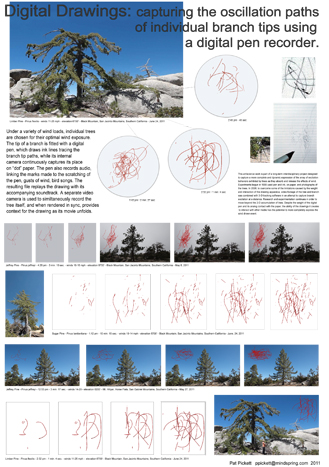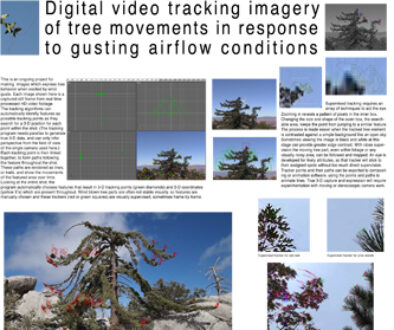IUFRO Wind and Trees International Conference, July 31- August 4, 2011 Department of Plant Biology, USDA Forest Service, The University of Georgia
IUFRO Wind and Trees International Conference, July 31- August 4, 2011 Department of Plant Biology, USDA Forest Service, The University of Georgia
Capturing the Damped Oscillation Paths of Individual Branch Tips Using a Digital Pen Recorder
P.Pickett
Under various wind loads, individual trees are chosen for optimal wind exposure. The tips of branches are fitted with digital pens, which draw ink lines tracking branch tip paths, capturing the movement over time.
This work is part of a long-term interdisciplinary artistic and scientific project, with the aim of capturing a more complete and dynamic expression of the array of excitation behaviors exhibited by branch tips as they absorb and release the effects of wind. Experiments begun in 1999 used pen and ink, on paper and photographs of the trees. By 2008, in an attempt to overcome some of the limitations caused by the weight and interaction of the drawing apparatus, video footage of the tree and branch was combined with 3-D tracking software in order to attempt to trace the branch movement, and to capture branch excitation, at a distance.
While research and experimentation continues in order to move beyond the 2-D accumulation of lines, towards a 3-D representation of branches through space; the digital pen recordings begin to address the unfolding of time. The resulting digital file, will “replay” the “drawing”, as it has been created over time, along with an accompanying soundtrack. In addition, in spite of the digital pen’s weight and analog interaction with paper, it will provide the ability to analyze the direction, amplitude and frequency of the oscillations of the branch during a sudden or sustained gust. Empirical data is noted, including duration, time of day, wind speed, temperature, meteorological conditions, elevation, location and date. To complete the picture, a video is simultaneously made of the entire tree and the selected branch, and synced with the digital drawing in order to compare the effects of the wind on the entire tree with the responses of the individual branch tip.
Bio-mechanics, influence of branches on tree sway, branches of tree as individual damped oscillators



